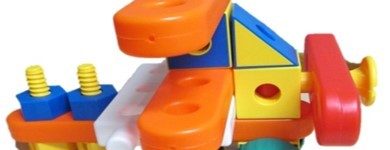Intentionally incorporating vision with hand function Visual perceptual skills do not operate in isolation. For efficiency, the brain incorporates eye movements with neural pathways that extend to include language, vestibular, and hand function skills. This is one of the primary reasons why many pediatric occupational therapists provide “heavy work” movement activities for children before sitting them down at a table for hand function
Learn more
Bilateral Motor Control refers to incorporating use of both sides of the body during motor activities. The processes are also commonly referred to as Bilateral Motor Integration. Typically, bilateral motor control refers to incorporating either symmetrical or reciprocal motor patterns. An example of symmetrical motor patterns is shown above as the children lift both arms of their bodies in a joyous expression. An example
Learn more
Heavy work activities are often used to improve postural control and upper body stability. The heavy work helps to modulate attention and to prepare the upper body to support follow up fine motor skills. However, physioball walk outs and other resistive activities commonly used for heavy work can easily become routine, resulting in decreased attention to task and postural control. We found a discounted
Learn more
In part, because the fingers are situated away from the center of the body, and they require more brain power to access, coordinated improvement of finger patterns are among the latest to develop during childhood. Infants are born with grasp pattern reflexes that allow them to hold objects early in development. However, integrated patterns of touch sensations followed by motor expression begin to take
Learn more
Visual sequencing essentially incorporates the use of language skills as you talk yourself through a task. However the activity presented to this youngster incorporates a wealth of additional learning skills. Visual Sequencing involves use of the concept “what comes next?” This is a vital reading readiness skill in that the youngster is required to mentally organize a series of visual images/letters along with their
Learn more
Navigational skills – being able to sequentially follow directions does not come easily for persons with Sensory Processing Dysfunction. While many might consider this skill to be somewhat intuitive, developmental theorists have shown us that this skill initially develops in childhood from learning experiences we have with manipulating objects in space. It is from this basic platform of building and constructing projects that the
Learn more
Getting youngsters with Sensory Processing Disorders to sustain visual attention and visual pursuits as needed for greater success in reading and exploring the environment can be problematic. Without sustained visual attention, the ability to name and understand the functionality of whatever it is you are looking at, is difficult. Without the ability to sustain looking for visual pursuit of the object as it moves,
Learn more
Sustained attention to task Visual Sequencing Skills We began incorporating use of digital task cards in treatment to promote increased use of Executive Functions including: Sustained attention to task Task organization Working memory Self monitoring We found the children were better able to pace their level of activity (some were under-aroused while others tended to be over-aroused) as they sustained attention to the digital
Learn more
Many children who have Sensory Processing Dysfunction (SPD) also have difficulty with Visual Association skills (the ability to connect language with visual images). Research using Diffusion tensor Imaging shows us that this may be due to poor connectivity of brain pathways responsible for linking the visual cortex with the language cortex of the brain. Fortunately, when children are young and the cortex of the
Learn more
As a sensory modality, vision tends to guide many of our motor moves. Vision is designed to work with balance, control of posture, language, motor skills and intellectual development. For example, a baby learns early on how to use vision for guiding muscles of the neck and mouth toward a nipple for food and comfort. Later on, the infant will learn how to use
Learn more






